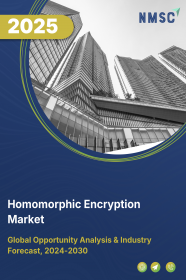
Homomorphic Encryption Market by Component, (Solutions, Services), by Technology, (Homomorphic Encryption Algorithms, Integration Protocols), by Encryption Type, (Partial Homomorphic Encryption (PHE), Additive Homomorphic Encryption, Multiplicative Homomorphic Encryption, Fully Homomorphic Encryption (FHE)), by Deployment Mode, (Cloud-Hosted / SaaS / API Platforms, On-Premises / Licensed Software, Hybrid & Edge Deployments) - Global Opportunity Analysis and Industry Forecast 2023-2030
Market Definition
The global Homomorphic Encryption Market size was valued at USD 189.5 million in 2022 and is predicted to reach USD 358.9 million by 2030 with a CAGR of 8.3% from 2023-2030. Homomorphic encryption is a cryptographic technique that allows computations to be performed on encrypted data without the need for decryption. It enables data to remain encrypted while still being processed, preserving privacy and security. With homomorphic encryption, computations can be conducted on the encrypted data, and the results can be obtained in an encrypted form, which can then be decrypted to reveal the desired output. This innovative encryption method has significant applications in secure cloud computing, data privacy, and confidential data processing.
Market Dynamics and Trends
The demand for homomorphic encryption is increasing due to the growing adoption of cloud computing and the need for secure data storage and transmission. Homomorphic encryption provides a secure way to store and transmit data in the cloud. It enables data to be processed while remaining encrypted, eliminating the need to decrypt it beforehand.
Also, the rising concern about data privacy and security, as businesses and individuals are becoming increasingly aware of the risks of data breaches and cyber-attacks is further boosting the growth of the market. According to the Federal Bureau of Investigation’s internet crime report 2022, 800,944 complaints of cyber-crime were reported to the FBI, a 5 percent decrease from 2021 in the U.S. However, the potential total loss increased to USD 10.2 billion in 2022, up from USD 6.9 billion in 2021. Homomorphic encryption can protect against these threats by providing an additional layer of security for sensitive data.
Additionally, government in various countries has implemented data protection, privacy laws and industry specific regulations to protect sensitive data and ensure privacy, which in turn boosts the market growth. According to UNCTAD data, 66% of the nations of the world safeguard people’s data and privacy, an 11% increase in the adoption of data protection and privacy legislation in the period 2015-2020.
However, the high computational complexity and cost associated with homomorphic encryption are the factors restraining the growth of the market. Homomorphic encryption algorithms require high computational power and resources, which can be expensive and time-consuming for businesses to implement and maintain. On the other hand, the introduction of fully homomorphic encryption (FHE), enabling a broader range of computations on encrypted data is expected to create ample growth opportunities for the market in the future. FHE allows complex computations to be carried out on encrypted data, making it extremely powerful.
Market Segmentation and Scope of Study
The global homomorphic encryption market report is segmented on the basis of type, component, application, end-user, and geography. Based on type, the market is classified into partially, somewhat, and fully. Based on the components, the market is segmented into solutions and services. Solution is further subdivided into encrypted data analytics, encrypted ai/ml data modelling, encrypted database querying, encrypted biometrics and behavioral data, and encrypted data linkage. Service is further sub segmented into managed service and professional service. On the basis of application, the market is categorized into secure data computation, data monetization, data privacy, and regulatory compliance. On the basis of end users, the market is bifurcated into BFSI, healthcare, government, and others. Geographical breakdown and analysis of each of the aforesaid classifications include regions comprising of North America, Europe, Asia-Pacific, and RoW.
Geographical Analysis
North America dominates the global homomorphic encryption market share and is expected to remain dominant in the market throughout the forecast period. This is attributed to the rising demand for data security and privacy as the number of data theft is increasing in North American countries including the United States. According to a report published by Federal Trade Commission in February 2022, shows that consumers in the United States reported losing more than USD 5.8 billion to frauds in 2021.
Moreover, the availability of developed IT infrastructure along with rising investment in cutting-edge technology such as artificial intelligence, cloud computing, and others are further boosting the growth of the global market. For instance, in June 2021 Pentagon and the U.S. Department of Defense (DOD) jointly planned to spend USD 874 million on artificial intelligence (AI) and machine learning technologies in 2022.
On the other hand, Europe shows substantial growth in the global homomorphic encryption market owing to the increasing focus on data privacy and security in the region. In March 8, 2023, the UK government presented the Data Protection and Digital Information (No. 2) Bill to the Parliament. The primary aim of this bill is to modernize and streamline the data protection laws in the U.K., along with specific other legislations. The process of passing the bill through Parliament is anticipated to conclude by the end of 2023.
Moreover, in August 2022, the UK government announced its plans to introduce a Data Reform Bill with the intent to create a new data regime and enhance data protection regulation under its overarching National Data Strategy. This is expected to give individuals greater a clarity over their rights and a clearer sense of how to determine access to, and benefit from their own data.
In addition, the increasing use of big data analytics and the development of new homomorphic encryption technologies in government sectors are also contributing to the growth of the market in Europe. For instance, in February 2022, the European Commission proposed a draft of a regulation on harmonized rules on fair access to and use of data also known as the Data Act. The Data Act is part of the Commission’s broader digital and data strategy to make “Europe fit for the Digital Age”
Competitive Landscape
The homomorphic encryption industry includes several market players such as IBM Corporation, Microsoft Corporation, Intel Corporation, Google LLC, Thales Group, NEC Corporation, Zama AI, Inc, Duality Technologies Inc, Enveil Corporation, CryptoLab Inc, Cosmian SASSAP SE, Galois, Inc, TripleBlind Inc, TNO (Netherlands Organization for Applied Scientific Research).
For instance, in June 2025 Zama AI, Inc Zama achieved unicorn status, raising $57M in Series B funding, reaching a valuation over $1 billion. They launched a Confidential Blockchain Protocol with FHEVM testnet and aim to support EVM chains and Solana by 2026.
Also, in August 2023, Microsoft Corporation Microsoft expanded its FHE toolkit, releasing hardware, a crypto library, and an open-source compiler toolchain to enable computational tasks—including video processing—on encrypted data.
Moreover, in August 2023, Google LLCGoogle rolled out enhancements to its FHE offering, including tooling that enables video file processing using FHE, alongside hardware and compiler tools to broaden HE application capabilities.
Key Benefits
-
The report provides quantitative analysis and estimations of the homomorphic encryption market from 2023 to 2030, which assists in identifying the prevailing market opportunities.
-
The study comprises a deep dive analysis of the homomorphic encryption market including the current and future trends to depict prevalent investment pockets in the market.
-
Information related to key drivers, restraints, and opportunities and their impact on the homomorphic encryption market is provided in the report.
-
Competitive analysis of the players, along with their market share is provided in the report.
-
SWOT analysis and Porters Five Forces model is elaborated in the study.
-
Value chain analysis in the market study provides a clear picture of roles of stakeholders.
Hmomorphic Encryption Market Key Segments
By Component
-
Solutions
-
Encrypted Data Analytics
-
Encrypted Ai/ml Data Modelling
-
Encrypted Data Linkage
-
Encrypted Database Querying
-
Encrypted Biometrics & Behavioral Data
-
Blockchain-integrated Solutions
-
-
Services
-
Consulting & Integration
-
Managed & Support Services
-
By Technology
-
Homomorphic Encryption Algorithms
-
Lattice-based (fhew Tfhe)
-
Integer-based (paillier)
-
RLWE- based (BGV CKKS)
-
-
Integration Protocols
-
Apis (ibm Fully Homomorphic Encryption Toolkit)
-
Zero-knowledge Proof Combos (zama)
-
Hardware Acceleration Interfaces
-
By Encryption Type
-
Partial Homomorphic Encryption (PHE
-
Additive Homomorphic Encryption
-
Multiplicative Homomorphic Encryption
-
Fully Homomorphic Encryption (FHE)
By Deployment Mode
-
Cloud-hosted / Saas / Api Platforms
-
On-premises / Licensed Software
-
Hybrid & Edge Deployments
By Organization Size
-
Large Enterprises
-
Small And Medium-sized Enterprises (SMES)
-
Government Agencies & Research Institutions
By Application
-
Secure Computing & Transactions
-
Secure Data Computation
-
Secure Transactions
-
Secure Voting
-
-
Regulatory And Compliance
-
Data Monetization & Analytics
-
Data Monetization
-
Fraud Detection
-
Real-time Decision-making
-
Workforce Optimization (WFO)
-
-
Data Management & Integration
-
Communication & Service Quality
-
Call Routing & Queuing
-
Chat Quality & Monitoring
-
-
Healthcare & Life Sciences
-
Genomic Analysis
-
Patient Data Sharing
-
-
Government & Defense
By Industry Vertical
-
Banking, Financial Services & Insurance (bfsi)
-
Healthcare & Life Sciences
-
Government, Defense & Public Sector
-
Retail & E-commerce
-
Telecommunications & It Services
-
Industrial & Manufacturing
-
Energy & Utilities
-
Others
By Region
-
North America
-
The U.S.
-
Canada
-
Mexico
-
-
Europe
-
The UK
-
Germany
-
France
-
Italy
-
Spain
-
Denmark
-
Netherlands
-
Finland
-
Sweden
-
Norway
-
Russia
-
Rest of Europe
-
-
Asia-Pacific
-
China
-
Japan
-
India
-
South Korea
-
Australia
-
Indonesia
-
Singapore
-
Taiwan
-
Thailand
-
Rest of Asia-Pacific
-
-
RoW
-
Latin America
-
Middle East
-
Africa
-
Key Players
-
IBM Corporation
-
Microsoft Corporation
-
Intel Corporation
-
Google LLC
-
Thales Group
-
NEC Corporation
-
Zama AI, Inc.
-
Duality Technologies Inc.
-
Enveil Corporation
-
CryptoLab Inc.
-
Cosmian SAS
-
SAP SE
-
Galois, Inc.
-
TripleBlind Inc.
-
TNO (Netherlands Organization for Applied Scientific Research)
Report Scope and Segmentation:
|
Parameters |
Details |
|
Market Size in 2022 |
USD 189.5 Million |
|
Revenue Forecast in 2030 |
USD 358.9 Million |
|
Growth Rate |
CAGR of 8.3% from 2023 to 2030 |
|
Analysis Period |
2022–2030 |
|
Base Year Considered |
2022 |
|
Forecast Period |
2023–2030 |
|
Market Size Estimation |
Million (USD) |
|
Growth Factors |
The rising concern about data privacy and security Government initiatives for data security and privacy Growing adoption of cloud computing in organizations |
|
Countries Covered |
28 |
|
Companies Profiled |
15 |
|
Market Share |
Available for 10 companies |
|
Customization Scope |
Free customization (equivalent up to 80 working hours of analysts) after purchase. Addition or alteration to country, regional, and segment scope. |
|
Pricing and Purchase Options |
Avail customized purchase options to meet your exact research needs. |

















 Speak to Our Analyst
Speak to Our Analyst
























